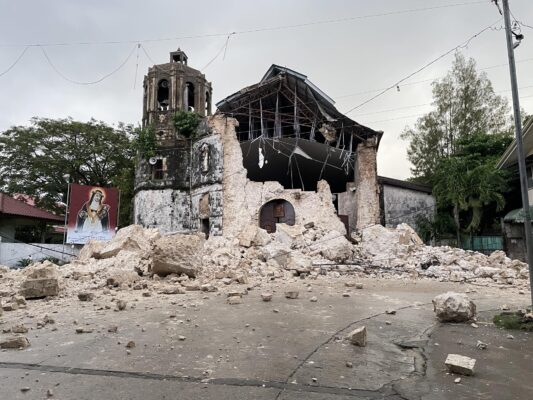The death toll from the 6.9-magnitude earthquake that struck the central Philippines climbed to 69 by Wednesday, according to a disaster official. Following one of the strongest quakes the country has seen in a decade, authorities immediately launched a major rescue effort to find potential survivors.
Read Also
The shallow tremor hit late on Tuesday just off the coast of Cebu Island, immediately damaging buildings and causing widespread power cuts. The number of missing persons, however, could not be immediately confirmed, Reuters reported.
Jane Abapo of the regional Civil Defence office confirmed that the death toll stood at 69 as of late Wednesday morning, stressing that the figures, which originated from the provincial disaster agency, were still subject to final validation.
The national disaster agency earlier said the toll could be as high as 60, with 150 reported injured.
The hospital in Bogo City near the epicentre of the quake was “overwhelmed”, Civil Defence official Raffy Alejandro told reporters.
The Philippine Coast Guard immediately dispatched a vessel carrying dozens of doctors, nurses, and medical personnel to Bogo. Meanwhile, President Ferdinand Marcos Jr assured survivors of swift assistance, with cabinet secretaries on the ground personally directing the relief operations.
“We are assessing the damage, we are assessing the needs,” Marcos told reporters after distributing aid in Masbate, an island recovering from the impact of Super Typhoon Ragasa last week.
Mariano Martinez, the mayor of San Remigio municipality close to Bogo, said there were 11 casualties in the area, with victims as young as 12 and the death toll expected to climb.
“Our first main problem is finding the casualties, identifying people who need help”, he told DZMM radio, adding many homes had suffered damage.
Earthquake monitoring agencies assessed the quake’s depth at approximately 10 km (6.2 miles) and recorded numerous aftershocks, with the largest measuring a magnitude of 6.0. Crucially, there was no tsunami threat detected following the main tremor.
The Philippines lies in the Pacific “Ring of Fire,” where volcanic activity and earthquakes are common. The country had two major earthquakes in January, with no casualties reported.
In 2023, a 6.7 magnitude offshore earthquake killed eight people.
San Remigio Vice Mayor Alfie Reynes said among those killed were people who were playing basketball in a sports complex when it partially collapsed.
She appealed for food and water for evacuees, as well as heavy equipment to aid search and rescue workers.
“It is raining heavily and there is no electricity, so we really need help, especially in the northern part, because there’s a scarcity of water after supply lines were damaged by the earthquake,” Reynes said.
Footage released by local media showed residents rushing from their homes as the ground shuddered and buildings collapsed. Among the destruction was a church, confirmed to be over a century old.
Cebu, one of the Philippines’ most popular tourist destinations, is home to 3.4 million people. It was not immediately clear the extent of the damage in other areas of the island.
The Mactan-Cebu International Airport, the country’s second busiest gateway, remained operational.
Philippine seismology agency Phivolcs said close to 800 aftershocks have been recorded and warned affected areas to expect more tremors in the coming days, although their strength is expected to gradually diminish.
It reported tremors as far south as Zamboanga del Norte, 330 km (205 miles) away.
In the town of Pilar, resident Archel Coraza said most of his family were asleep when their house began to shake violently.
“I woke them up and we all rushed outside into the street,” he told DZMM.





